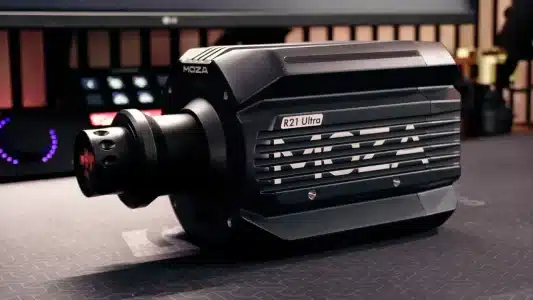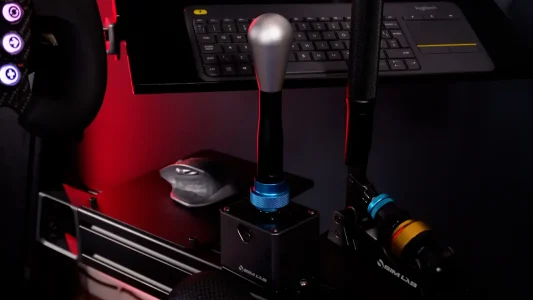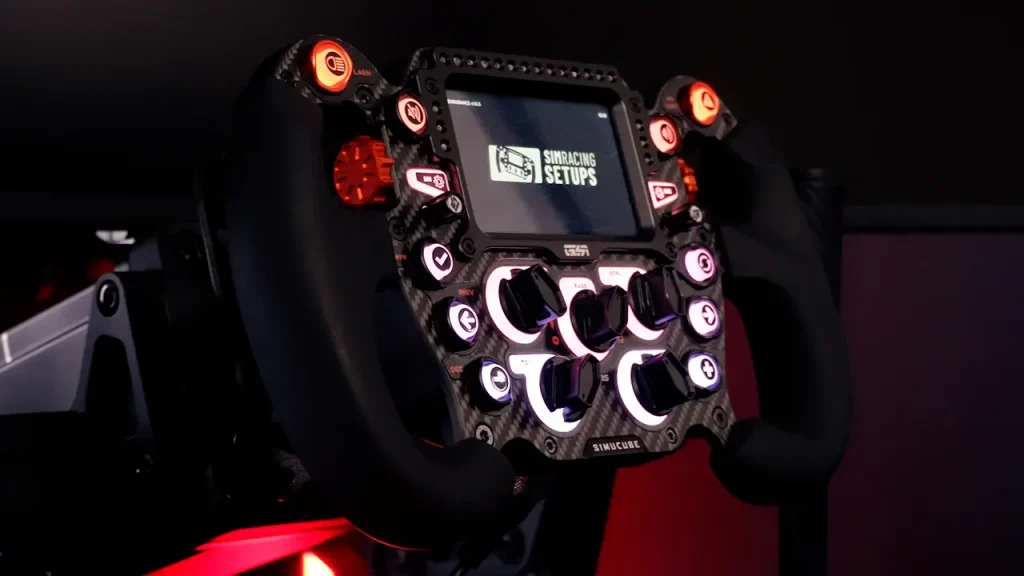
Our Verdict
Pros
- Completely customisable when purchased from GSI.
- Incredibly comfortable hand grips and ergonomics.
- Overall design and build quality is incredibly good.
- RGB lighting highly customisable in SimHub, and looks fantastic when racing at night.
- All inputs perform flawlessly, with sharp and tight inputs.
- Comes pre-installed with Simucube quick release.
Cons
- Only PC compatible.
- Very expensive.
- Lack of customisation on the Simucube edition.
- Dual-clutch paddle positioning a little far from the wheel.
- SimOS software not very good.
There is no getting away from the fact that the GSI Formula Pro Elite V2 steering wheel is one of the prettiest wheels around. It features a huge range of inputs, incredible build quality, super chunky handgrips and a built in display.
This limited edition Simucube variant swaps out the coloured accents with a Simucube orange colourway, and features the Simucube branding across the wheel.
But priced at over €1800 for the wheel alone, or from €2800 as part of a bundle with a Simucube wheel base. Does this wheel live up to its incredibly high price tag, and are the improvements over the original FPE wheel worth the re-release?
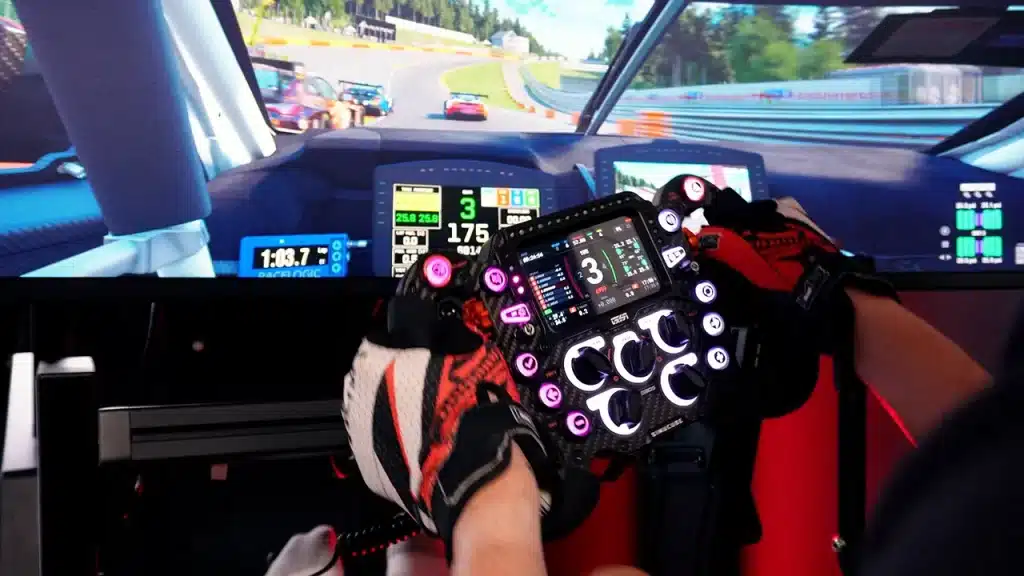
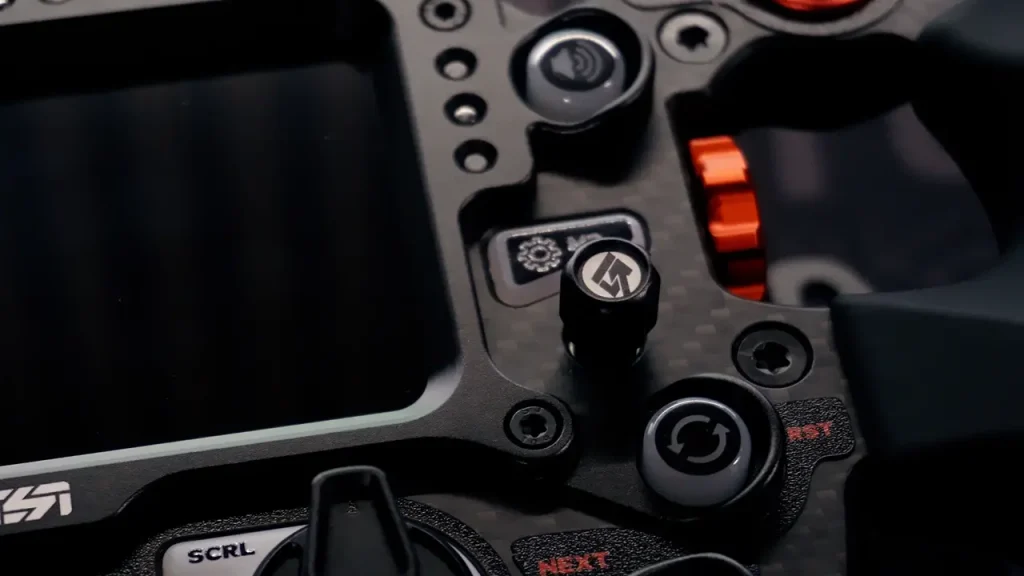
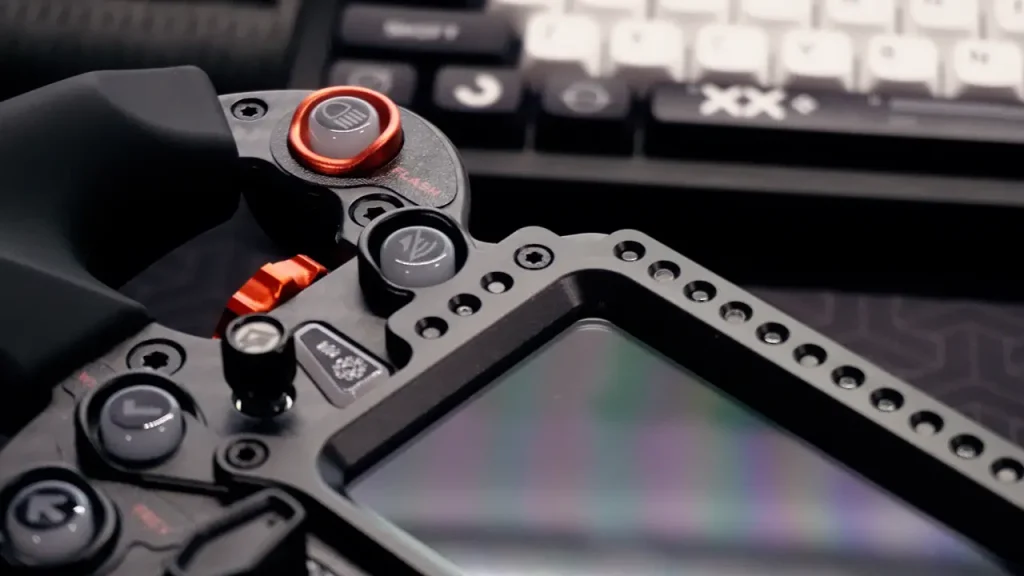
I’ve been sent this wheel to review, and I’ve had it for a good few months now. It’s been my primary wheel, paired with a Simucube 2 Pro wheel base on my Sim-Lab rig, meaning I’ve spent a good few hundred hours racing with this thing. So let’s jump right into this review.
Watch our GSI FPE V2 Steering Wheel Review
Price of the GSI FPE V2 Steering Wheel
I want to start with the huge elephant that is always lingering in the room when we talk about this wheel, and that is the price point. GSI produces some of the most premium sim racing wheels you’ll find, with prices starting from just under £500, €550 or $650 with the X-29 wheel.
This FPE V2 wheel sits way above the X-29 in both functionality and price, although it’s not the most premium wheel GSI offer. That award goes to the Hyper P1.
This standard GSI FPE V2 wheel starts from £942, €1092 or $1250, before sales tax. And this limited edition Simucube variant adds an additional few hundred on top of the price. For that extra price, you’re basically getting a pre-installed Simucube quick release and a new orange colourway.
| Product | Price |
|---|---|
| GSI FPE V2 Steering Wheel | UK: £1425.00 EU: €1881.25 US: $1579.00 |
| Simucube x GSI FPE V2 Bundle | EU: €3047.39 US: $2725.20 |
What is the competition?
At that price point, we’re looking at competitors such as the Asetek Invicta Formula Wheel at around €1300, the Cube Controls CSX-3 at €1300, the Fanatec BMW M4 GT3 wheel at around €1500 or the Ascher Racing Artura Ultimate, also at €1500.
That is some serious firepower and competition that this GSI wheel has to beat. So let’s look at what makes this wheel stand out in this crowded premium market.


Unboxing and what’s included
Starting at the top, the premium nature of this wheel is evident from the unboxing. There is orange and silver foil across the outer packaging, and the wheel is nestled snuggly in custom fit foam padding.
Inside the box is an uncluttered affair. You’ll find just the wheel with the pre-installed quick release, and the coiled cable, and that is about it. But really, there isn’t much else you need.


The design of the Gomez Sim Industries FPE V2
First impressions of the wheel are incredibly positive from the moment we unleash it from its cage. The build quality is outstanding, with a 5mm carbon fiber faceplate and an aluminium body. And every single input feels incredible to interact with, but I’ll touch more on that later in the review.
Design overview
This is a 300mm formula-style wheel that is ever so slightly narrower than the original thanks to the reduced hand grip size. Those handgrips are still incredibly chunky, with the silicone design being molded perfectly to my grip.
The rounded bottom of the handles lends the wheel nicely to other classes such as GT or LMP racing, making it incredibly versatile. Although, there is a slight downside with the handles in that they can’t be removed or swapped out with other styles.
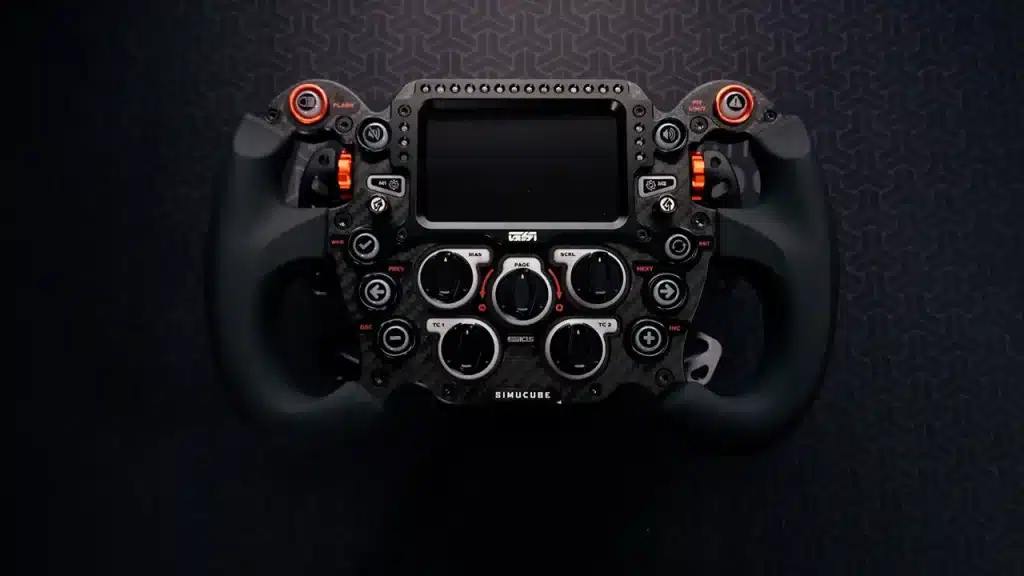
Push buttons
Talking of inputs though, you get a huge amount with this wheel. There are 10 front facing push buttons, all of which are LED backlit and feature a scratch resistant button cover.
One thing to note right away, is that these push buttons come pre-installed with non interchangeable button covers. You can’t simply whack a new sticker on the button cap like you can with most wheels.
What you do get though is complete customisation over the button style when shopping for the wheel. On the GSI website, you can change the button cap icon, as well as the sticker colour next to it. This does let you lay out your wheel however you want from the get go. Although, it’s worth noting, this functionality isn’t available with the Simucube edition.
I do like this pre-installed, ready to roll approach, as you know the quality of the button caps and sticker installation will always be perfect. One of my biggest complaints when reviewing the Asetek Invicta wheel, was that the stickers I had to install myself, looked a little wonky or ill fitting. This is something that is not a problem here.
Although, one small note is that the top right button cap, I did notice it has been put on ever so slightly at a wonk. This is a very small blemish in what is an otherwise excellently built wheel.

Encoders
Huddled in the center of the wheel are five rotary encoders. These are constructed from 6061 aluminium, and unlike the button caps, they can be swapped out for different colours. They feature 12 inputs per encoder as well as push functionality, and have a customisable LED light behind each one.
New to the FPE V2 are an additional two thumb encoders that are positioned perfectly next to your natural thumb position. These are by far the best positioned thumb encoders I’ve come across with a very similar position to my beloved Fanatec Formula V2.5x, and offer just the right amount of resistance.
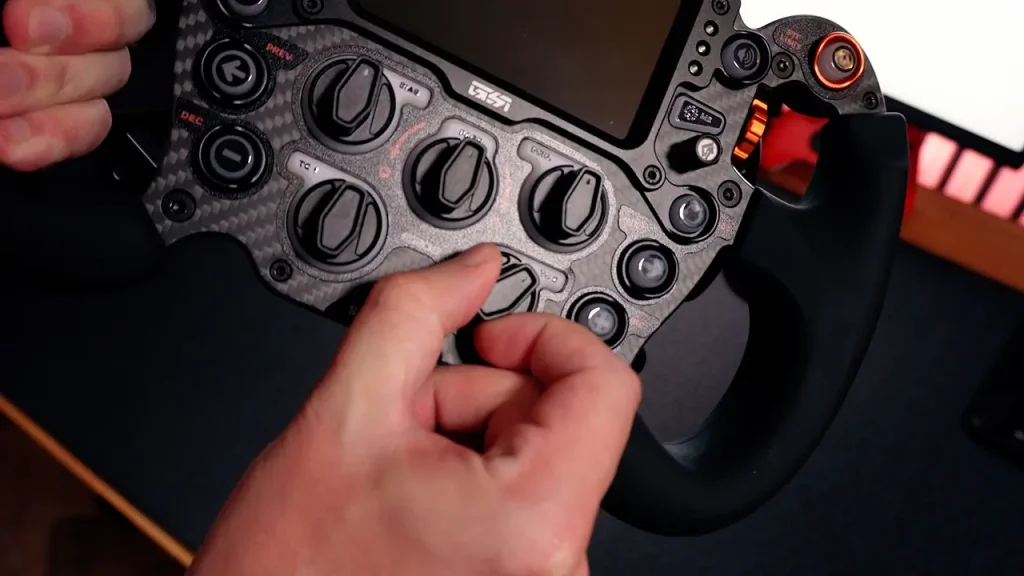
7-way switches
Rounding out the front-facing inputs are two 7-way switches. These are ideal for navigating menus or your black box while on track, and are invaluable on a sim steering wheel. A neat little design touch is the included inset G logo on the front of each one.
Rev lights
Like nearly all premium wheels, there is a complete array of rev and flag lights included. Unlike wheels such as the Asetek Invicta, or the Sim-Lab Mercedes-AMG F1 wheel, these aren’t covered by the glass screen.
Instead, they’re shrouded by the metal border that extends all the way from the display. This gives them a slightly nicer, more tactile appearance compared with those other wheels. These lights can be fully configured using SimHub.
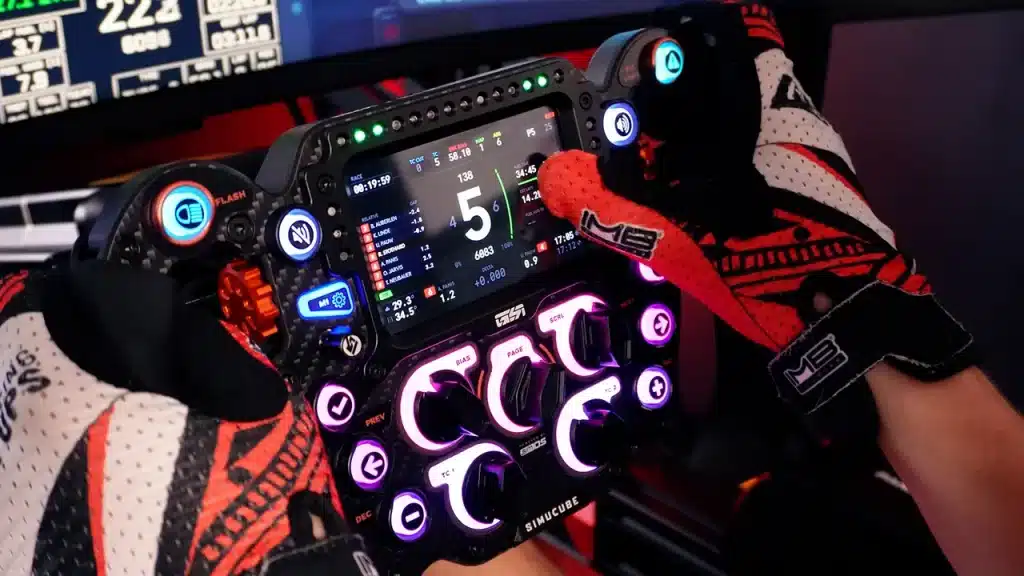
The digital display
Our design review of the front of this wheel isn’t complete without addressing the built in display. This display comes in at 4.3 inches across, and features touch screen capabilities. The image is incredibly sharp due to the high resolution, and when you jump into SimHub, the customisation options are endless.
Shifters
Flipping the wheel over, we can see the quick release, shifters and the cable connection. I won’t talk too much about the quick release, as this Simucube edition comes with their own QR pre-installed. And you can swap this out for any quick release hub that uses a 70mm PCD.
This Simucube edition features four paddles, two incredibly well dampened neodymium magnetic shifters and two additional analogue paddles that are ideal for clutch activation. There is a two paddle option available which brings the weight and cost down.
You don’t get any adjustment with the positioning of the paddles, but GSI have done an excellent job on that front. The shifters are perfect in both length and position, making them very comfy to use. The lower clutch paddles though do require a slight hand position adjustment to comfortably use.

The weight of the wheel
All of the included functionality, and premium materials do lead to this wheel feeling heavy. Coming in at just over 1.5kg for the four paddle configuration that I have here, or around 100 grams lighter for the two paddle wheel. That puts it up there with competitors such as the Asetek Invicta wheel. Although it does represent a weight saving of around 20% over the original FPE wheel.
For me, the weight isn’t as issue, as I stupidly associate weight with quality, as dumb as that may be. Typically, you’re going to be pairing this wheel with an equally impressive direct drive wheel base, which will be more than powerful enough to make this wheel feel as responsive as any other.
Differences between the GSI FPE V2 vs the original FPE
Before jumping into the performance part of the review, I want to look at how this FPE V2 wheel differs from the original, as there are a few significant changes.
First up, the V2 wheel features a range of elements that weren’t included on the original. The two thumb encoders are new, the six flag lights are new, and the 7-way switch has been moved and a second one added. Another big change that really elevates this wheel is the inclusion of RGB lighting throughout. All push buttons are now backlit, as are the front facing encoders.
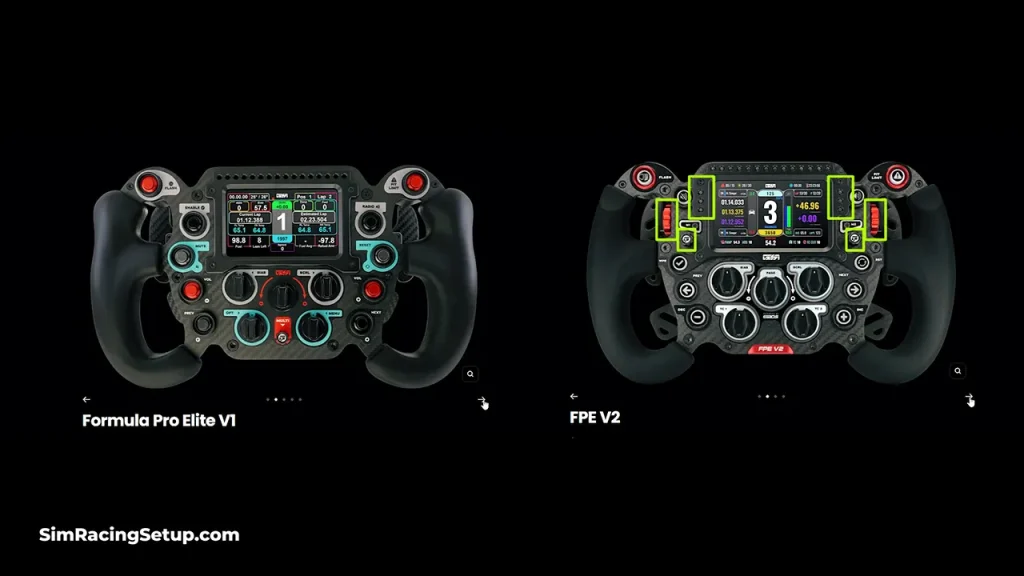
Outside of this, improvements have been made throughout. The hand grips are slightly thinner and have better ergonomics. The shifter paddle design has been updated, as has the rotary encoder design. And the layout of the push buttons has been tweaked to accommodate the new M1 and M2 lights and the 7-way switches.
The big news with the FPE V2 is that the price has remained the same as the original. All of the new additions really do elevate the wheel in terms of quality, making it much more well rounded.
Software
Now software is a tricky part of this review. GSI does have its own SimOS software which is used to update the FPE V2 and adjust various settings. SimOS doesn’t really stretch beyond this though. You cannot customise the LED profiles or the dash. For that, you need SimHub.
This isn’t a huge issue as SimHub is so widely used and available for free. However, I do like the option to have some customisation within a manufacturers software. Sim-Lab do this well with their wheels, offering a variety of dashboard to choose from. And this can just bypass the need to install SimHub if you aren’t already using it.
Within the SimHub download files for the FPE V2 is a dash layout and a variety of LED profiles. These offer a few colourways and behavioural patterns. But things really start to come alive when using profiles such as those from Daniel Newman Racing, or Lovely Dashboard.
You can configure a few things within SimOS. These include the behaviour of the dual clutch paddles, the bite point and certain encoder behaviour such as staying latched when pushed. I guess GSI thought that most sim racers will be using SimHub, so they relied on that for the customisation side of things.
Performance review
With the wheel on the rig, lets start to talk about how this steering wheel performs. First of all, I want to look at the inputs, and their overall quality in the heat of a race. These are really broken down into three.

There are the push buttons, encoders and shifters. I just want to say the added RGB lighting makes the world of difference over the original. The LEDs around the front facing encoders also feature a gradient effect allowing for some pretty neat designs.
Input performance
You can now see all inputs when racing at night or in a dark room. And choosing a good set of LED profiles can really elevate your visual experience both on and off the track.
The push buttons themselves feel fantastic to operate. Each one requires 500 grams of force to engage, and has a distinctly short throw, and there is zero wobble on any of the push buttons.
Moving to the encoders and the story is very similar. Each adjustment is very clicky, in a good way, and they sit right in that sweet spot of resistance. Each encoder is light enough to rotate so they feel comfortable, but stiff enough to the point where you won’t be making any unintended changes.
Finally, it’s no surprise that the shifters also feel top tier. GSI have implemented really nice damping to the magnetic paddles. The resistance is actually on the slightly lighter side compared to some wheels. And the throw is around 8-9mm. Overall they feel fantastic to use.

The dual clutches just below feature more resistance than the shifters, and can be configured for launch control, a true dual clutch, or as throttle and brake inputs. For me, the positioning of these analogue paddles is a little off.
They are flared out at the rear, which is common for dual clutch paddles. However, the angle is a little more extreme than say on the Asetek Invicta wheel. This means, they are almost just out of reach with my hands in a natural driving position. To compensate, I had to lower my hand position a little, which is something I don’t need to do on other wheels. Those with bigger hands won’t have as much of an issue, but those with hands smaller than mine will struggle to reach.
Screen performance
When on the track, the screen is one of the primary areas of the wheel you’ll be looking at. It is touchscreen, meaning you can also interact with it, switching layouts etc. The response of the display is incredible, giving real-time readouts of all crucial information with no lag.
Using the DNR dash profiles, I was able to configure almost every part of this display to my own liking. This meant setting up spotter info, lap time data, tyre info and much more. The animations that play when adjusting your brake bias, or completing a lap, are incredibly smooth, and the brightness of the screen is very good, even in a brightly lit room.

Overall performance
As a whole, this wheel performs incredibly well, no matter which game I was playing. Like all premium PC steering wheels, there is a fair bit of setup required. You need to update the wheel in GSI’s software, then set up your SimHub profiles for the dash and the LEDs. And finally, configure all inputs and button mapping in game.
Once you’re past that though, everything works like a dream. The 300mm diameter is perfect, and despite its weight at 1.5kg, the wheel still portrays force feedback from my Simucube wheel nicely. I would imagine on a wheel below say 10Nm of peak torque, the wheel’s weight could dampen some FFB. But I had no such issue with my Simucube or Fanatec wheels.
One thing that really stands out while racing, is the excellent ergonomics that GSI have baked in. The improved hand grips allowed my hands to wrap nicely into a comfortable position. All push buttons are within reach without having to remove my hand, and the activation of all encoders feels super sweet and crispy.
Is the GSI FPE V2 Steering Wheel worth buying?
Choosing a premium sim racing steering wheel really is a big decision. Most sim racers aren’t likely to have multiple premium wheels laying around, so choosing your weapon is a decision well worth contemplating.
This FPE V2 wheel though, would make an excellent choice for most. It blends incredibly high build quality, with great design decisions and ergonomics. Little details such as the G logo on the 7-way switches, and the perfectly placed pre-installed stickers and button caps, really elevate this wheel from a functional steering wheel, to a true piece of art.

There are some small cons though. Despite the large amount of customisation with the base FPE V2 wheel, the Simucube edition lacks all customisation. The handgrips cannot be interchanged, meaning you can’t swap them out with suede or replace them as they wear. And the lack of first party software functionality are small hurdles in an otherwise outstanding sim racing wheel.
It says a lot, that when I’ve got the replica Mercedes-AMG F1 wheel, and the Asetek Invicta wheel laying around my studio, that this is my most used wheel over the past 3 months. Quite frankly, I love almost every part of it, and it really is close to being a perfect sim racing steering wheel.
Frequently asked questions
The GSI FPE V2 can be used with any wheel base that uses a 70mm PCD mounting pattern. It has a direct-to-PC USB connection, making it incredibly universal.
The second generation of the Formula Pro Elite features many improvements over the original. There are new thumb encoders, an additional joystick, added rev lights, and redesigned handles and shifter paddles.
Technical Specifications
Review written by Felix König










